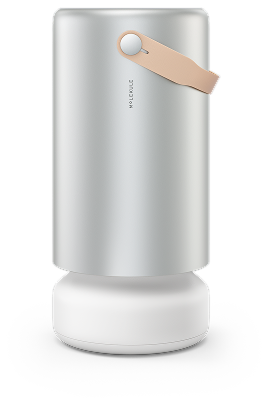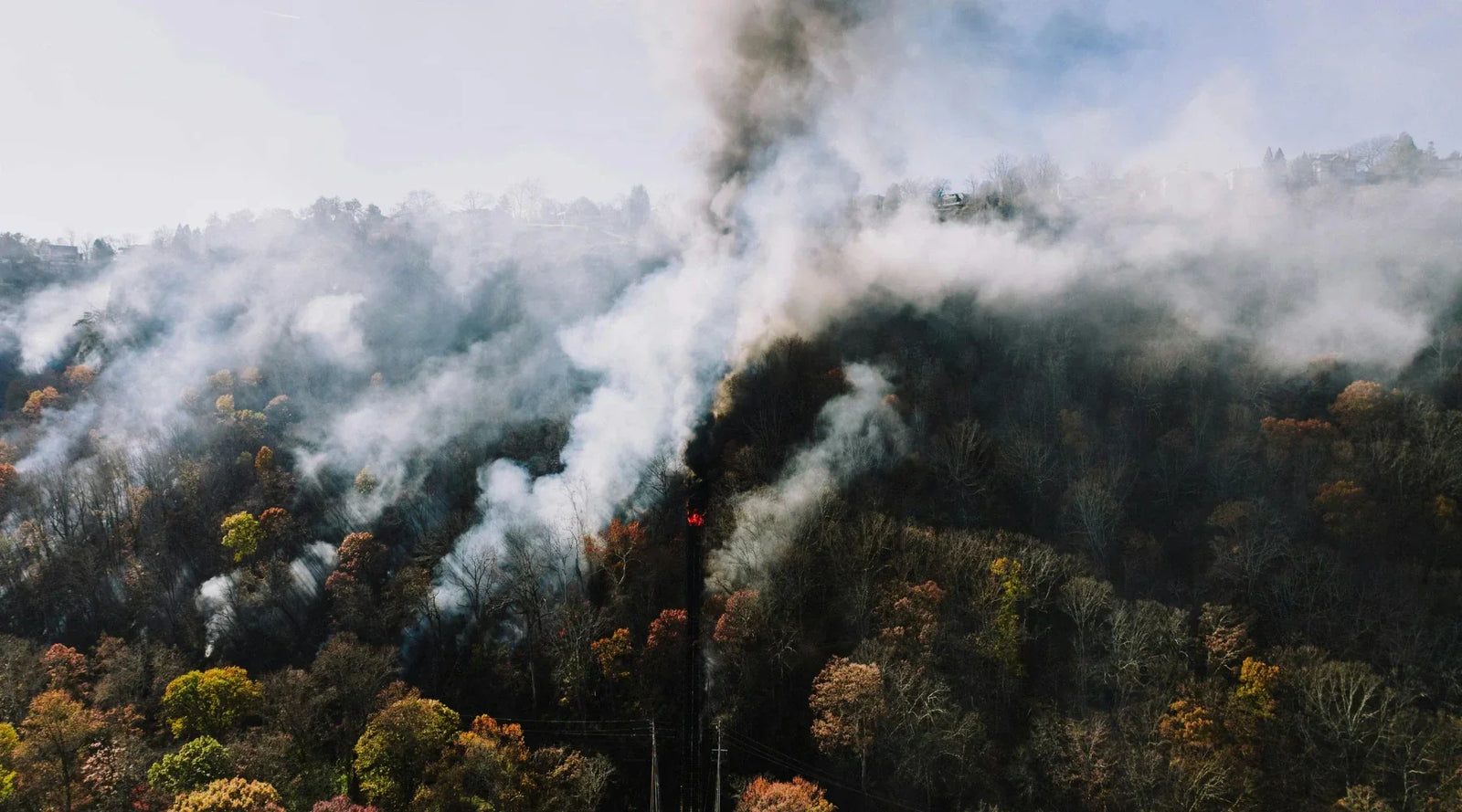Wildfires can ignite in seconds and spread at astonishing rates. This rapid progression means a small spark can become a life-threatening inferno in minutes, not hours. As flames advance, they also generate dense smoke that can travel miles ahead of the fire line, prompting many residents to rely on air purifiers to maintain breathable indoor air even before evacuation orders are issued.
The speed of wildfire spread depends on multiple factors: wind conditions, fuel type and moisture, topography, temperature, and humidity. Understanding these dynamics is crucial for your safety, as evacuation timeframes can shrink dramatically when fires accelerate. Let’s discuss the critical wildfire behavior patterns that could give you the extra minutes you need to escape safely.
The Science Behind Wildfire Ignition
The transformation from a small spark to a raging wildfire occurs with surprising speed (up to 14 miles per hour), often catching people off guard. This rapid ignition process follows fundamental principles of combustion science that explain why wildfires can start so quickly.
The Fire Triangle: Foundation of Rapid Ignition
For any fire to ignite and spread rapidly, three elements must come together:
-
Fuel: Vegetation, structures, or other combustible materials
-
Oxygen: Typically abundant in the atmosphere (21%)
-
Heat: The ignition source that raises fuel to its combustion temperature
When these elements combine under just-right conditions, ignition can happen almost instantaneously. The speed depends primarily on how quickly fuel reaches its ignition temperature — a threshold that materials can cross far faster than most people realize.
Ignition Time by Heat Source
Different ignition sources transfer heat at varying rates, affecting how quickly a wildfire can start.
|
Ignition Source |
Time to Ignition |
Temperature Range |
Common Location |
|
Direct flame |
1-5 seconds |
1,500-1,800°F |
Campfires, matches |
|
Cigarette |
30-60 seconds |
450-550°F |
Roadsides, trails |
|
Hot exhaust |
30-120 seconds |
500-1,000°F |
Dry grass parking |
|
Lightning |
Instantaneous |
50,000°F |
Open areas, trees |
|
Power lines |
1-30 seconds |
1,000-2,000°F |
Utility corridors |
|
Hot metal fragments |
5-60 seconds |
700-1,200°F |
Equipment use |
Fuel Moisture Content
The moisture content of potential fuels dramatically affects ignition speed. When vegetation contains less water, it ignites faster and burns more intensely:
Dead fine fuels (grass, leaves, pine needles) with moisture content below 5% can ignite within seconds. Meanwhile, live fuels typically need to be preheated longer to drive off moisture. During extreme drought conditions, live fuel moisture can drop to dangerously low levels
Field tests have shown that dried grass exposed to a cigarette can transition from smoldering to flaming in under 60 seconds when humidity is low and temperatures are high. This explains why carelessly discarded smoking materials remain a significant cause of wildfires.
How a Fire Starts to Spread
The transformation from the first contact with a heat source to a spreading fire follows these phases:
-
Preheating: Fuel temperature rises but remains below ignition point (seconds to minutes).
-
Pyrolysis: Chemical decomposition begins, releasing flammable gases (seconds to minutes).
-
Piloted ignition: Gases ignite when exposed to flame or spark (instantaneous).
-
Transition to spreading fire: Flames generate sufficient heat to ignite adjacent fuels (seconds to minutes).
The entire sequence from preheating to spreading fire can occur in less than 30 seconds under ideal conditions of low humidity, high temperatures, and fine, dry fuels.
Laboratory vs. Real-World Ignition Speeds
Research conducted at the U.S. Forest Service Fire Sciences Laboratory has documented ignition times that highlight the speed at which fires can start:
-
Pine needles exposed to small flame: 1-3 seconds to ignition
-
Dead grass exposed to cigarette: 30-60 seconds to transition from smoldering to flame
-
Dried leaves exposed to spark: 5-10 seconds to sustained flame
-
Wood shavings exposed to hot metal: 15-30 seconds to flaming combustion
These laboratory findings align with observations from real-world accidental ignitions, where witnesses report similarly rapid fire development in dry conditions.
During prolonged smoke events, even areas far from the ignition point can experience hazardous air quality, making air purifiers for smoke a vital tool for maintaining your indoor air safety while awaiting official guidance or evacuation. After a wildfire has passed, an air purifier can also help you get rid of lingering fire smoke smells.
Understanding the science behind rapid ignition helps explain why seemingly minor heat sources — such as a trailer chain dragging on pavement, a lawnmower blade striking a rock, or a tossed cigarette — can trigger catastrophic wildfires in mere seconds under the right conditions. This knowledge underscores the critical importance of practicing fire prevention and maintaining your awareness during periods of elevated fire danger.
Measuring Wildfire Spread
Understanding how wildfires move across landscapes requires specific metrics that quantify their velocity. These measurements help firefighters predict fire behavior, plan tactics, and determine evacuation timeframes for at-risk communities.
Rate of Spread
The most common metric for wildfire speed is rate of spread (ROS), which measures how quickly the fire’s leading edge or flaming front advances:
-
Units of measure: Chains per hour (1 chain = 66 feet), feet per minute, or acres per hour
-
Typical forest fire ROS: 5-15 chains per hour (5.5-16.5 feet per minute) under moderate conditions
-
Extreme forest fire ROS: Can exceed 100+ chains per hour (110+ feet per minute)
-
Grassland fire ROS: Often 3-4 times faster than forest fires, reaching 60+ chains per hour
-
Record-setting ROS: Some Australian grassfires have been documented exceeding 25 miles per hour
When fire officials report that a fire is “moving at 3 mph,” they're referring to this horizontal spread rate of the main fire front.
Relationship Between Fire Intensity and Speed
Fire intensity (energy release per unit length of fire front) correlates strongly with spread rate. Higher intensity fires typically spread faster and create more spot fires ahead of the main front, further accelerating overall fire progression.
|
Fire Intensity Level |
Heat Output (kW/m) |
Typical ROS |
Control Difficulty |
|
Low |
<500 |
1-3 chains/hour |
Direct attack possible |
|
Moderate |
500-2,000 |
3-10 chains/hour |
Control lines needed |
|
High |
2,000-4,000 |
10-30 chains/hour |
Spotting begins |
|
Very High |
4,000-10,000 |
30-60 chains/hour |
Crown fire activity |
|
Extreme |
>10,000 |
>60 chains/hour |
Uncontrollable |
Spotting Distance: Leap-Frogging Ahead
One of the most dangerous aspects of wildfire spread is spotting — when embers are carried ahead of the main fire front to start new fires:
-
Short-range spotting: 0-0.25 miles ahead (common in most wildfires)
-
Medium-range spotting: 0.25-0.5 miles ahead (common in high-intensity fires)
-
Long-range spotting: 0.5-1.0 miles ahead (occurs during extreme conditions)
-
Extreme spotting: >1.0 mile (rare but documented in severe fires)
During the 2019-2020 Australian bushfires, people reported spotting distances of up to 18 miles — an extraordinary example of how quickly fires can effectively “jump” across landscapes.
Perimeter Growth Rate
In addition to how fast a wildfire moves forward, another critical metric is the rate at which its total perimeter expands — a key indicator of how quickly the fire is growing in all directions.
During the initial growth phase, small fires may expand at a relatively modest rate, adding approximately 0.5 to 2 miles of perimeter per hour. However, once a fire becomes established and encounters favorable conditions such as dry fuels, high winds, and low humidity, its growth can accelerate significantly. Under these circumstances, fires commonly add between 5 and 10 miles of perimeter per hour.
In cases of extreme fire behavior, perimeter growth can be even more explosive, with documented instances of fires expanding by more than 15 miles in a single hour. Over a 24-hour period, large wildfires often increase their perimeter by 20 to 40 miles, making containment efforts extremely difficult and increasing the risk to nearby communities.
How Firefighters Measure Spread Rates
Modern fire management teams use advanced technologies to measure spread rates:
-
Infrared mapping aircraft: Capture fire perimeter growth hourly
-
Satellite thermal detection: Measures large-scale progression
-
Drone surveillance: Provides real-time spread data in specific areas
-
Fire behavior analysis units: Calculate and predict spread rates
-
Wildfire modeling software: Projects potential spread based on conditions
Historical Examples of Spread Rates
Some of the fastest documented spread rates provide perspective on how quickly wildfires can move:
-
2018 CampFire (California): Expanded at approximately 80 football fields per minute during its most active period
-
2017 Tubbs Fire (California): Advanced more than a mile in just 20 minutes
-
2009 Black Saturday Fires (Australia): Moved at speeds estimated at 12-19 mph
-
2003 Cedar Fire (California): Traveled 29 miles in its first 14 hours
-
1988 Canyon Creek Fire (Montana): Advanced 7 miles in a single hour
These historical examples demonstrate how, under extreme conditions, wildfires can outpace humans on foot and sometimes even those in vehicles, explaining why early evacuation is crucial during fire emergencies, especially for the most vulnerable among the population, such as seniors, children, and those with allergies or asthma or other respiratory conditions.
Understanding these metrics helps both fire managers and the public grasp the true nature of wildfire spread rates. While the average person might think in terms of “fast” or “slow” fires, these quantitative measurements provide precise language for communicating the speed at which wildfires can threaten lives and property.
Environmental Factors That Accelerate Wildfire Spread
Multiple environmental conditions dramatically influence how quickly wildfires advance across landscapes. These four factors often combine or interact to create ideal conditions for extreme fire spread rates.
1. Wind: The Primary Driver
Among all environmental influences, wind is the most powerful accelerator of wildfire spread, capable of turning a moderate blaze into an uncontrollable disaster within minutes. Fire behavior research consistently shows that spread rates often increase in direct proportion to wind speed, meaning that as wind intensifies, so does the fire’s pace across the landscape.
Wind feeds the combustion zone with a steady supply of oxygen, sustaining and intensifying the flames. It also plays a key role in the preheating of unburned fuels by pushing hot air and flames ahead of the fire front, which lowers ignition thresholds and enables faster spread.
One of wind’s most dangerous contributions is its ability to transport embers — small burning particles that can ignite spot fires far ahead of the main blaze, sometimes miles away. When wind direction aligns with upward-sloping terrain, this effect is further magnified, as fires naturally move faster uphill.
Critical Wind Speed Thresholds
|
Wind Speed |
Typical Effect on Fire Spread |
Control Implications |
|
0-5 mph |
Normal spread rates |
Direct attack possible |
|
5-10 mph |
2-3× increase in spread rate |
Flank attacks preferred |
|
10-20 mph |
4-8× increase in spread rate |
Indirect tactics needed |
|
20-30 mph |
8-15× increase in spread rate |
Defensive operations only |
|
30+ mph |
Extreme, erratic spread |
Evacuation focus |
2. Topography: How Terrain Accelerates Fires
The landscape's shape significantly impacts fire spread velocity:
-
Slope effect: Fire spreads approximately 4× faster uphill on a 40% slope than on flat ground.
-
Aspect influence: South and southwest-facing slopes receive more solar radiation, creating drier fuels that burn faster.
-
Canyons and drainages: Act as chimneys, creating strong updrafts that accelerate fire.
-
Saddles and mountain passes: Concentrate wind, increasing local spread rates.
-
Ridgetops: Often experience stronger winds that drive faster spread.
The combined effect of steep slopes and wind can create explosive fire growth. During the 2018 Camp Fire, people observed flames moving upslope at rates exceeding 2 miles in just 30 minutes.
3. Fuel Characteristics: What Burns Fastest
Different vegetation types support dramatically different spread rates:
-
Grasses: Fastest-spreading fuel type, allowing rates of 15-20+ mph during extreme conditions.
-
Shrubs and chaparral: Support rapid spread of 5-10 mph with high flame lengths.
-
Timber with understory: Moderate spread rates but high intensity.
-
Closed timber canopy: Generally slower spread unless crown fire develops.
-
Slash and logging debris: Slow initial spread but extreme intensity.
Fuel arrangement also matters significantly. For example, continuous fuels, such as uninterrupted grasslands or dense brush, allow flames to move quickly across the landscape, while patchy or discontinuous fuels can slow or even stop fire spread.
Vertical fuel continuity — when lower vegetation like shrubs or small trees forms a “ladder” up to taller trees — enables fires to climb from the ground into the canopy, leading to crown fires that are much harder to control. Meanwhile, fine fuels like dry grass, leaves, and pine needles ignite and spread most rapidly, and compact fuels such as tightly packed branches or wet leaf litter burn more slowly due to limited airflow and higher moisture retention.
4. Weather Conditions Beyond Wind
Multiple weather factors work together to influence spread rates:
-
Low relative humidity (below 20%): Dramatically increases fuel flammability and ignition speed.
-
High temperatures (above 90°F): Preheats fuels and reduces moisture content.
-
Drought conditions: Create critically dry fuels that support rapid fire growth.
-
Atmospheric instability: Enhances vertical development of smoke columns and fire intensity.
-
Preceding rainfall patterns: Determine live and dead fuel moisture content.
When these factors align — what fire managers call a “perfect storm” scenario — spread rates can exceed all predictions and challenge even the most experienced firefighters.
Weather That Creates Extreme Spread Conditions
Specific weather patterns create the conditions for fast wildfire spread rates, and large wildfires can even generate their own weather systems that accelerate spread. Here are some connections between weather and fire spread rates:
-
Pyrocumulus clouds: Fire-created clouds that can collapse and cause erratic winds.
-
Fire whirls: Spinning vortices of flame that can move unpredictably at high speeds.
-
Fire tornados: Extreme fire whirls with rotational velocities exceeding 100 mph.
-
Convection columns: Create strong inflow winds that feed the fire's oxygen demand.
During the 2018 Carr Fire in California, a fire tornado with winds exceeding 143 mph developed, creating spread patterns that defied all prediction models.
Regional Wind Events
Certain geographic regions experience unique wind conditions that drive extreme fire spread. When these regional winds coincide with dry conditions, they create the recipe for the fastest-spreading wildfires on record. The most destructive California fires have almost all occurred during these wind events:
-
Santa Ana winds (Southern California): Dry, warm downslope winds that frequently drive the region's fastest-spreading fires.
-
Diablo winds (Northern California): Similar to Santa Anas, these northeast winds created conditions for the Wine Country fires.
-
Chinook winds (Rocky Mountains): Warm, dry downslope winds that can rapidly melt snow and dry fuels.
-
Sundowner winds (Santa Barbara): Late afternoon winds that align with local topography.
-
Foehn winds (Global): Downslope winds that increase temperature and decrease humidity.
How Embers Accelerate Wildfire Spread
Perhaps the most dangerous aspect of rapidly spreading wildfires is their ability to “jump” ahead through ember transport, accelerating spread far beyond the main fire front.
These small, burning fragments of vegetation or debris are carried by wind — sometimes for miles — and can ignite spot fires well beyond established control lines or natural barriers. This phenomenon, often referred to as the leap-frog effect, enables wildfires to bypass defenses and accelerate in multiple directions simultaneously.
As embers create new ignition points ahead of the main blaze, the fire’s growth can become exponential, with multiple fronts expanding at once. This not only overwhelms firefighting resources but also circumvents many traditional containment strategies, such as firebreaks and retardant lines, which are designed to slow or stop a single advancing front — not dozens of new fires igniting unpredictably ahead of it.
The result is a highly volatile situation where evacuation zones must expand rapidly, often with little warning, putting entire communities at risk. Because ember-driven spot fires can ignite roofs, decks, and other vulnerable parts of structures, they are also a leading cause of home loss during wildfires, even in areas not directly touched by the main fire line.
Activities That Increase the Risk of Wildfires and Spread Rates
While natural factors influence how quickly wildfires spread, human activities often create the initial conditions for rapid fire development:
-
Power infrastructure failures: Broken power lines can shower sparks across wide areas.
-
Vehicle-related starts: Dragging chains, hot exhaust systems, and catalytic converters ignite roadside vegetation.
-
Equipment use: Lawnmowers, chainsaws, and other tools create sparks that ignite dry grass.
-
Debris burning: Escaped control burns spread rapidly under unexpected wind shifts.
-
Discarded cigarettes: Still account for thousands of wildfire starts annually.
-
Arson: Deliberately set fires, sometimes during already dangerous fire conditions.
These human causes are responsible for the vast majority of all wildfire ignitions, many of which occur under conditions conducive to rapid spread.
As climate change continues to create hotter, drier conditions across many regions, the potential for extreme fire behavior — including unprecedented spread rates — only increases. The lesson is clear: wildfire preparation must happen well before fires start, and evacuation decisions must be made with the understanding that fires often move much faster than expected.
In addition to practicing fire prevention and adhering to burn bans, preparing your home with protective measures — such as defensible landscaping, fire-resistant materials, and home air purifiers — can make a critical difference in both safety and comfort during a wildfire emergency.
Frequently Asked Questions
How fast can a wildfire spread in ideal conditions?
In grasslands with high winds, wildfires can spread at 20+ mph. Forest fires typically move slower (1-6 mph) but can throw embers miles ahead.
Can I outrun a wildfire?
Most people cannot outrun a fast-moving wildfire on foot. Even in vehicles, evacuation can be dangerous if you wait until the fire is visible.
How quickly can a small fire become dangerous?
A match-sized fire can grow to an acre within 30-60 seconds in dry grass with moderate winds.
Do wildfires slow down at night?
Fires typically slow at night due to increased humidity and calmer winds, but dangerous spread can still occur during nighttime “downslope” wind events.
How far can wildfire embers travel?
Embers commonly travel 0.5-1 mile ahead of a fire front, but distances of 5+ miles have been documented during extreme events.







